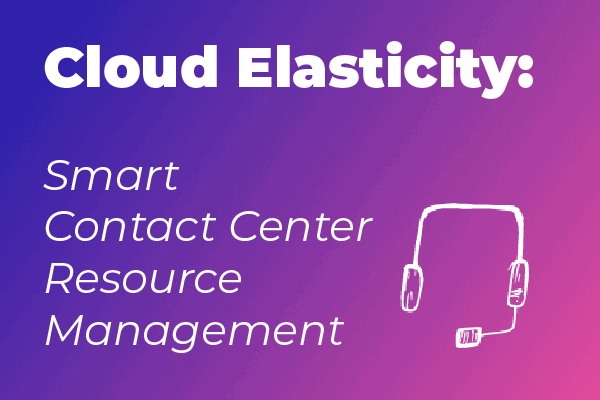As we entered the age of big data and made the shift from the call center to the contact center industry, resource management became one of the most important tactical business aspects. In a world where uncertainty rules supreme, having an elastic and scalable technical infrastructure is probably one of the most important tactical decisions a call center can make.
Contact centers and cloud computing
Before we dive into the elasticity and scalability discussion, we need to take a quick look at what the cloud computing revolution meant for the contact center industry.
Before the cloud, call centers would buy physical hardware architectures that needed to be shipped to the locations and installed. This process was called local premise-based installation. The call centers would also buy the licenses for whatever software solutions they wanted to deploy. In short, everything was owned by the call center, and this meant extra expenses such as professional services (installation, training, development) plus annual maintenance paid to the infrastructure providers. Read more on How to choose a Call Center Provider.
However, over the last 15 years, the concept of cloud computing slowly started to take over our industry. Today, companies such as Amazon (via Amazon Web Services: AWS) are selling cloud infrastructures as a service.
Here is where infrastructure providers such as NobelBiz are building and perfecting separate contact center instances, creating fully functional out-of-the-box contact center solutions. Now, everything from hardware infrastructure and maintenance costs to security and software integrations is delegated entirely to the provider. And here is where the pay-as-you-go model comes into play and where the elasticity and scalability magic happens.
What is Elastic Cloud Computing?
As a general definition, elastic infrastructure is able to instantly and automatically expand and reduce allocated resources (computing power, memory, and storage capacity) according to the needs of a particular business, at a particular moment in time, without service interruption.
Top features of an elastic contact center
- High reliability: In general, for the cloud-powered contact centers, call quality and latency-related problems are only an issue of internet connection. A solid connection should eliminate these fears altogether as the leading cloud technologies are far superior to any premise-build infrastructure. For example, the NobelBiz OMNI+ infrastructure is using Amazon Web Services (AWS), offering the best-in-class service availability and performance, with insane failover safety redundancies.
- Easy growth: In the contact center world, growth is highly dependent on the available technical resources. Imagine wanting to double your number of agent seats without updating your entire infrastructure. Impossible, right? Well, not if you are using an elastic and scalable cloud solution.
- Automation: The increase and decrease of the allocated resources can be defined in advance so that in certain conditions (ex. high communication traffic) the system will automatically allocate more resources without service interruption.
- Cost-efficient: The elastic contact center can have access to the latest hardware and software developments in the industry without spending big on updates and maintenance. You only pay for what resources you use.
The advantages of the Pay-as-you-go model
Of course, Elasticity only makes sense in a cloud environment and it is fairly easy to see why this represents such a great business advantage for many industries, not only for contact centers. This usually comes with the pay-per-use (or pay-as-you-go) pricing model and allows businesses to:
- Bypass the need for an initial expensive infrastructure
- Not worry about the hardware getting outdated
- Completely forget about hardware maintenance
- Have access to seasonal infrastructure updates
The elastic contact center: use cases
The use case of cloud elasticity for the contact center industry is now more relevant than ever. As the industry was basically forced to find alternative ways of remaining active while keeping the social distancing rules, virtually all call centers had to experiment with cloud computing, one way or another…
This unplanned experiment forced most contact centers to look beyond their pre-pandemic perspective and gave way to a host of new business revelations. Well, one of these revelations is the importance of Cloud Elasticity.
Staying open to business opportunities
Since forever, our industry was governed by a high level of uncertainty. When business opportunities come and go, realistic long-term planning becomes pure gambling. This is true especially when you have to decide if you want to invest for example, in a 100-seat or 200-seat hardware infrastructure.
What if you prepare your contact center to accommodate 100 agents, but a few months down the road you get a business opportunity that would require 200 or 300 seats? What if you lose a contract and you only require 50 agents?
Can you see the real value of built-in cloud elasticity capabilities? This might be a technical issue, but from a business perspective, this is huge! Elasticity creates swift and nimble contact centers that can navigate uncertain waters while also being able to take on new business opportunities on the fly.
Dealing with Seasonality
As we all know, virtually every type of contact center has to deal with some sort of seasonality, when rapid spikes in activity are followed by (un)determined periods of relative inactivity. Depending on the niche(s) you are involved in, you might face more or less of this activity fluctuation. However, no one seems to escape it.
These periods of intense activity are rather difficult to manage, and often put a great strain on both the infrastructure and the human resources of a contact center. Actually, this is the main reason why most contact centers fail to take full advantage of these intense timeframes: to tackle more calls or interactions, a call center needs to increase the number of agents, but this is not possible without an infrastructure update.
This is why there are only a few contact centers that can afford to ride the waves of seasonality by upgrading their infrastructure to accommodate more agents than they would normally use in the rest of the year.
But thanks to the new contact center platforms with built-in elasticity (such as NobelBiz OMNI+), even the smallest businesses can now take a share of the pie. Increasing your infrastructure capacity is just as simple as temporarily switching to another monthly plan that would allow you to instantly be able to onboard as many agents as you need.
Elasticity vs Scalability
Prior to the cloud computing revolution, elasticity was not an option, while scalability was definitely possible. However, true scalability could have only been achieved with a proper hardware update… Oh, how things have changed.
While both dimensions are fundamental for a solid contact center infrastructure, they differ in scope. As we have seen, elasticity is an elegant way to deal with sudden changes in resource requirements and optimizes the resource allocation process for short periods of time.
In contrast, scalability deals with future long-term development requirements, adding new capabilities and new elements in the grand scheme of things.
In short, while scalability deals with planned organic growth of capabilities, (a step up both in terms of software and hardware) elasticity provides for short-term demands in hardware output.
Takeaway
Few people in the contact center space are really aware of the huge advantage posed by an elastic cloud solution. If there is one business lesson we need to learn from the pandemic, it is that contact centers need to be nimble and quick on their feed if they want to survive. And cloud elasticity does just that. It allows contact centers to add and subtract resources depending on their momentary needs without spending big on hardware updates and maintenance. In short, it’s just smart resource management…
The shortest way to an elastic contact center: NobelBiz OMNI+
The easiest way for a contact center to take full advantage of an elastic and scalable infrastructure is to deploy a cloud contact center software solution such as NobelBiz OMNI+. This complete solution is built to meet all the needs of a contact center, regardless of the industry, niche, or size.
A truly elastic and scalable cloud platform allows unprecedented business mobility and opens the contact center to a whole new world of possibilities. Virtually all the infrastructure elements of the NobelBiz OMNI+ software are imbued with a healthy dose of elasticity. Speak to an expert now!

Andrei is an experienced marketing professional specializing in propelling growth for both B2B and B2C companies. Proficient in streamlining marketing operations and enhancing lead and customer experiences through SEO and marketing techniques.







